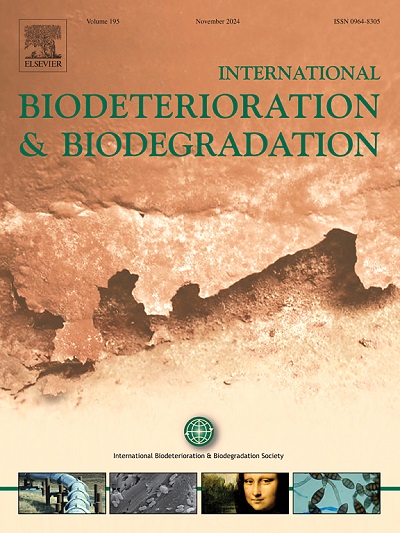Bioremediation of petroleum refinery wastewater using constructed wetlands: A focus on microbial diversity and pollutant degradation
IF 4.1
2区 环境科学与生态学
Q2 BIOTECHNOLOGY & APPLIED MICROBIOLOGY
International Biodeterioration & Biodegradation
Pub Date : 2025-06-13
DOI:10.1016/j.ibiod.2025.106152
引用次数: 0
Abstract
Horizontal flow constructed wetlands were evaluated for the treatment of synthetic petroleum refinery wastewater (PRW), with and without Typha latifolia. The synthetic PRW was formulated with a chemical oxygen demand (COD) of 1528.43 ± 125.8 mg/L, and contained diesel, phenol, 49.94 ± 1.48 mg/L of NH4+-N, 142.86 ± 4.26 mg/L of S2−, and 265.75 ± 4.28 mg/L of SO42−. The constructed wetlands (CW) were acclimated for 50 days under continuous flow, followed by three operational phases with varied hydraulic retention times. The synthetic PRW simulated with chemical oxygen demand (COD) of 1528.43 ± 125.8 mg/L, containing diesel and phenol, 49.94 ± 1.48 mg/L of NH4+-N, 142.86 ± 4.26 mg/L of S2−, and 265.75 ± 4.28 mg/L of SO42−. The CW was acclimated for 50 days with continuous flow, followed by three different operational phases with varied hydraulic retention times. Effluent COD in unplanted and planted CW systems were 74.44 ± 16.05 mg/L and 56.67 ± 0.14 mg/L, respectively, with NH4+-N removal rates of 75 % and 92 % over 7 days. S2− removal resulted in solid sulphur deposition and increased the SO42− concentration. Microbial dynamics revealed that Proteobacteria, Bacteroidetes, and Firmicutes were the dominant phyla, with genera such as Pseudomonas, Acinetobacter, and Bacillus identified as the key hydrocarbon-degrading bacteria. Gas chromatography-mass spectrometry (GC-MS) analysis confirmed the removal of hydrocarbons, with a reduction in the number of hydrocarbon compounds and generation of intermediate compounds in the effluent. This study highlights the potential application of HFCWs for the treatment of PRW by leveraging the synergistic effects of microbial activity and plant-mediated processes to enhance pollutant removal efficiency.

人工湿地对炼油废水的生物修复:微生物多样性和污染物降解的研究
研究了水平流人工湿地对炼油合成废水的处理效果。合成的PRW化学需氧量(COD)为1528.43±125.8 mg/L,含有柴油、苯酚、49.94±1.48 mg/L的NH4+-N、142.86±4.26 mg/L的S2−和265.75±4.28 mg/L的SO42−。人工湿地(CW)在连续流量下驯化了50天,然后进行了三个不同水力保留时间的操作阶段。模拟的合成水的化学需氧量(COD)为1528.43±125.8 mg/L,含柴油和苯酚,NH4+-N为49.94±1.48 mg/L, S2−为142.86±4.26 mg/L, SO42−为265.75±4.28 mg/L。在连续流动条件下对连续油管进行了50天的适应,然后进行了三个不同的操作阶段,这些阶段具有不同的水力滞留时间。未种植和种植的连续水处理系统出水COD分别为74.44±16.05 mg/L和56.67±0.14 mg/L, 7 d内NH4+-N去除率分别为75%和92%。S2−的去除导致固体硫沉积,SO42−浓度升高。微生物动力学结果表明,变形菌门、拟杆菌门和厚壁菌门为优势门,其中假单胞菌属、不动杆菌属和芽孢杆菌属是主要的烃降解菌。气相色谱-质谱(GC-MS)分析证实了碳氢化合物的去除,出水中碳氢化合物的数量和中间化合物的生成减少。本研究强调了HFCWs在处理PRW方面的潜在应用,通过利用微生物活性和植物介导过程的协同效应来提高污染物去除效率。
本文章由计算机程序翻译,如有差异,请以英文原文为准。
求助全文
约1分钟内获得全文
求助全文
来源期刊
CiteScore
9.60
自引率
10.40%
发文量
107
审稿时长
21 days
期刊介绍:
International Biodeterioration and Biodegradation publishes original research papers and reviews on the biological causes of deterioration or degradation.

 求助内容:
求助内容: 应助结果提醒方式:
应助结果提醒方式:


